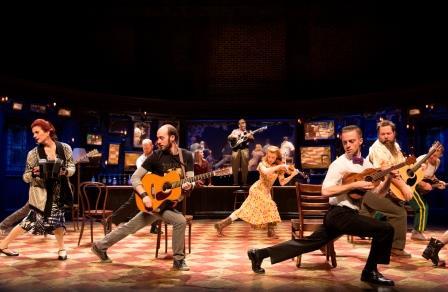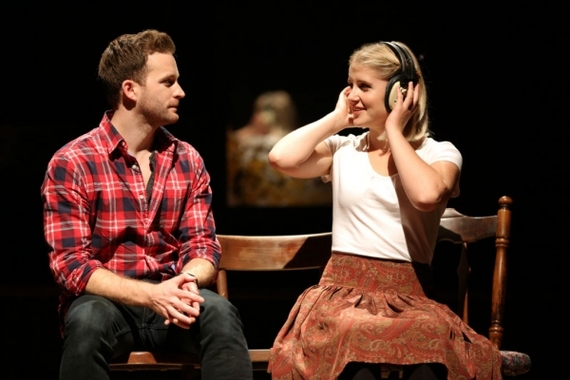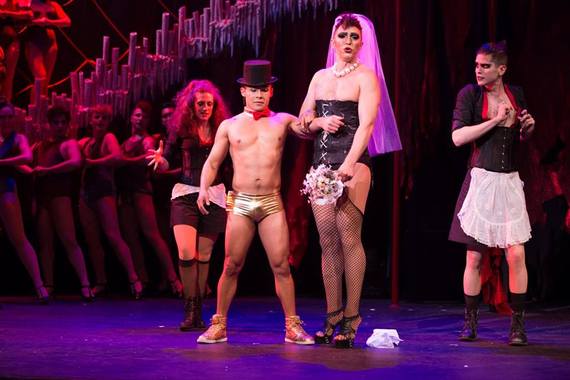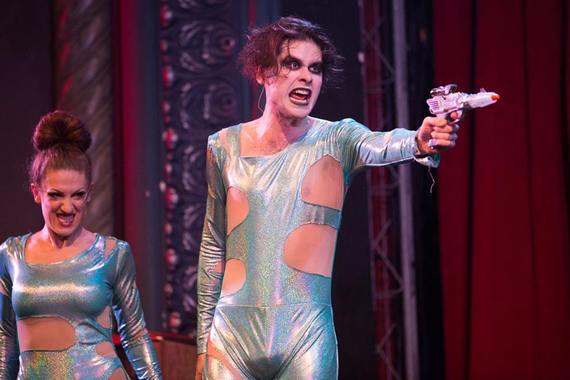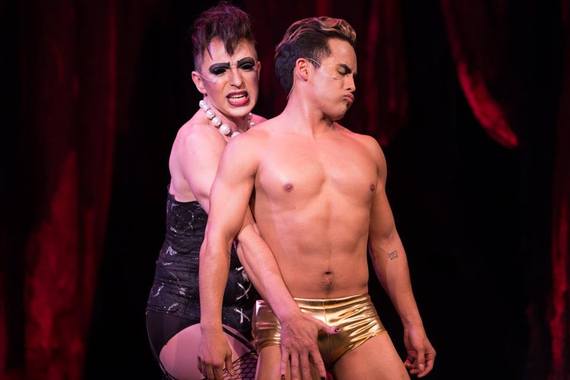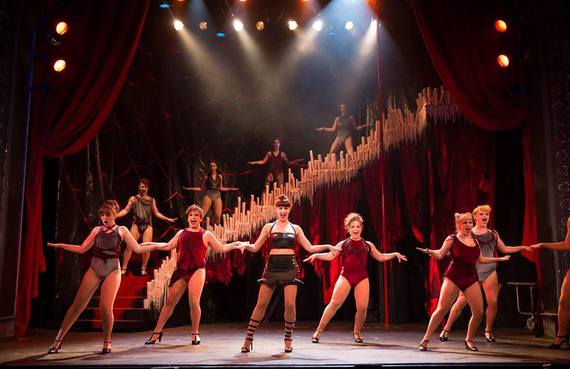By their very nature, successful musicals can generate royalties for their investors for many years after the show's initial run. If a stage musical becomes a big hit, the chances are pretty good that it will make it to the silver screen.
In recent years, there has been a growing trend for successful movies to be adapted into stage musicals. While the traditional stage-to-screen direction may have been reversed, one key factor remains the same: the bottom line with regard to an artist's intellectual property. Anything that can diversify a show's revenue stream so that money keeps coming in is a boon to the creative team and their angels.
As one examines past decades, interesting patterns start to emerge. From the 1940s to the 1980s, lots of stage musicals were transformed into movies:
- 1920s: Show Boat.
- 1930s: Anything Goes, DuBarry Was A Lady .
- 1940s: Annie Get Your Gun, Brigadoon, Carousel, Finian's Rainbow, Gentlemen Prefer Blondes, Lady in the Dark, Pal Joey, Kiss Me, Kate, South Pacific and Oklahoma!
- 1950s: Call Me Madam, Damn Yankees, Flower Drum Song, Guys and Dolls, Gypsy, The King and I, Kismet, The Music Man, My Fair Lady, The Pajama Game, Paint Your Wagon, Silk Stockings, The Sound of Music, and West Side Story.
- 1960s: A Funny Thing Happened on the Way to the Forum, Bye Bye Birdie, Cabaret, Camelot, Fiddler on the Roof, Funny Girl, Hair, Hello, Dolly! How to Succeed in Business Without Really Trying, Mame, Man of La Mancha, Sweet Charity, The Unsinkable Molly Brown, 1776, and Oliver!
- 1970s: A Chorus Line, Annie, A Little Night Music, The Best Little Whorehouse in Texas, Chicago, Evita, Godspell, Grease, Jesus Christ Superstar, and Sweeney Todd: The Demon Barber of Fleet Street.
- 1980s: Dreamgirls, Into the Woods, La Cage aux Folles, Les Misérables, Little Shop of Horrors, and The Phantom of the Opera.
- 1990s: Hedwig and the Angry Inch, Rent, and Mamma Mia!
- 2000s: Jersey Boys, The Producers.
However, from the 1980s to today, the direction has been reversed, with more films being adapted into stage musicals.
- 1960s: Carnival! Golden Rainbow, Henry, Sweet Henry, Here's Love, Illya Darling, Promises, Promises, Sweet Charity, and 110 in the Shade.
- 1970s: Applause, Ballroom, Gigi, On the 20th Century, Shenandoah, Sugar and The Wiz.
- 1980s: Carrie, Fame, Grand Hotel, Meet Me In St. Louis, Nine, Seven Brides for Seven Brothers, Singin' in the Rain, The Wizard of Oz, Woman of the Year, and 42nd Street.
- 1990s: Beauty and the Beast, Big: The Musical, Footloose, The Goodbye Girl, The Hunchback of Notre Dame, The Lion King, Martin Guerre, My Favorite Year, Passion, State Fair, Sunset Boulevard, Victor/Victoria, and The Wiz.
- 2000s: A Catered Affair, A Christmas Story: The Musical, Billy Elliot: The Musical, Chitty Chitty Bang Bang, The Color Purple, Cry-Baby, Dirty Rotten Scoundrels, Flashdance the Musical, The Full Monty, Grey Gardens, Hairspray, High School Musical on Stage! Legally Blonde, The Little Mermaid, Mary Poppins, Monty Python's Spamalot, Priscilla, Queen of the Desert, The Producers, Shrek The Musical, Sister Act, Sweet Smell of Success, Tarzan: The Musical, Thoroughly Modern Millie, White Christmas, Xanadu, Young Frankenstein, and 9 to 5.
- 2010s: Aladdin, An American in Paris, Bring It On: The Musical, Bullets Over Broadway, Catch Me If You Can, Elf: The Musical, Finding Neverland, Ghost the Musical, Heathers: The Musical, Honeymoon in Vegas, King Kong, Kinky Boots, Newsies, Rocky the Musical, School of Rock, and Women of the Verge of a Nervous Breakdown.
At the end of October I had a rare opportunity to attend performances of two beloved musicals. Although one began its life on a stage and drew a cult following for screenings of its film adaptation, the other began life as an independent film before being adapted for the musical stage. Needless to say, both properties have made their creators and investors extraordinarily happy.
* * * * * * * * * *
I first saw Once during the 2007 San Francisco International Film Festival. Written and directed by John Carney and filmed on a shoestring budget of approximately $160,000, the movie starred Glen Hansard and Markéta Irglová as two Dubliners down on their luck. The Guy was a busker who (when he wasn't playing guitar and performing his songs on Grafton Street) repaired vacuum cleaners at his father's appliance shop. The Girl was a Czech immigrant who sold flowers and played piano in a music store.
At its heart, Once might seem like a meet-cute love story. Deeper down, however, it is the tale of one musician being able to recognize the manifestation of another musician's insecurities bubbling to the surface and help him overcome his doubts and self-loathing in order to achieve his personal and professional goals. Following its theatrical release, Once won the 2008 Independent Spirit Award for Best Foreign Film. The movie's hit song, "Falling Slowly," won the 2007 Academy Award for Best Original Song.
The national touring cast of Once (Photo by: Joan Marcus)
The stage adaptation of Once had its world premiere in 2011 in a 100-seat venue at the American Repertory Theater in Cambridge, Massachusetts. The show opened on Broadway in 2012, was nominated for 11 Tony Awards and won eight (including Best Musical). Subsequent productions have been staged in Dublin, London, and Melbourne, Australia. As with the original film, the stage version of Once has developed a loyal following.
The national touring cast of Once (Photo by: Joan Marcus)
As someone who was severely underwhelmed by the movie, I was both surprised and delighted when the national tour arrived at the Curran Theatre in June of 2014. I found the stage adaptation to be a vastly improved experience which gave audiences a much warmer feeling for Ireland's pub culture (proving that live theatre can sometimes be a much warmer and more welcoming medium for a dangerously thin love story than a low-budget film).
Under John Tiffany's direction, an ensemble of multi-talented musicians (the kind that were once called "triple threat" performers) became a singing, dancing, acting, and music-making storytelling unit. Thanks to the powerful contribution of movement coach Steven Hoggett (who has obviously worked with the cast to develop specific bits of body language for each character) and Tiffany's masterful economy of action in moving props around the stage (as well as keeping the audience's focus), the stage adaptation of Once does a splendid job of reaping a great deal more entertainment from a small amount of source material than the film did. In the following clip, members of the Broadway cast of Once discuss their process during a 2013 AtGoogleTalks session.
On the national tour's return visit to San Francisco (this time at the 2,203-seat Orpheum Theatre), Stephen McIntyre drew sympathy from the audience as the Guy's soft-hearted father, with Jon-Alex MacFarlane scoring points as a bank officer with musical aspirations and Evan Harrington charming the audience as Billy (the manager of the music store where the Girl plays the piano). Among the ensemble, I was particularly impressed with Matt DeAngelis as the the pugnacious Svec, Claire Wellin as Reza, Alex Nee as Andrej (the burger boy who anticipates being promoted to a managerial position), and Tina Stafford as the Girl's mother, Baruška.
Stuart Ward and Dani de Waal star in the national
touring company of Once (Photo by: Joan Marcus)
As in 2014, the bulk of the evening rests on the shoulders of Stuart Ward and Dani de Waal as the two musicians who fall in love and slowly come to realize that tending to the responsibilities of their previous relationships is more important than consummating their current romance. Both have strong appeal and are excellent in their roles, with Ms. de Waal adding a particularly dry and blunt kind of humor to the evening as a "very serious Czech."
The songs by Hansard and Irglová (most especially "Leave," "Broken Hearted Hoover Fixer Sucker Guy," and "When Your Mind's Made Up") hold a powerful grip on the audience. Thankfully, the show's Oscar-winning hit song, "Falling Slowly" no longer feels like the cloying ear worm it did in the film. Unlike larger touring musicals which try to pummel their audiences into submission with amplification, the sound design in the Orpheum, for Once, was excellent (an all too rare achievement). Here's the trailer:
* * * * * * * * * *
Having just finished a run of Lizzie the Musical, San Francisco's ambitious Ray of Light Theatre treated its audience to a special Halloween run of The Rocky Horror Show. With book, music, and lyrics by Richard O'Brien, the musical's world premiere took place on June 19, 1973 at the Royal Court Theatre in London followed by an American premiere at the Roxy Theatre in Los Angeles in 1974.
Following a brief and financially unsuccessful run of 45 performances on Broadway in 1975 (Tim Curry starred as Dr. Frank 'N' Furter in all three stage productions), the film adaptation (entitled The Rocky Horror Picture Show) went into general release on August 15, 1975 with Curry again in the lead and Susan Sarandon, Barry Bostwick, Richard O'Brien, and Meat Loaf in supporting roles.
The rest, as they say, is history. Having earned nearly $140 million at box offices throughout North America and nearly $50 million in rentals, The Rocky Horror Picture Show holds the record for the longest-running theatrical release in history. In 2005, it was chosen by the Library of Congress for preservation in the United States National Film Registry. Tentatively planned to air as a two-hour television special in late 2016 is a new version directed by Kenny Ortega starring a real transsexual (Laverne Cox) entitled The Rocky Horror Picture Show Event.
D'Arcy Drollinger stars as Dr. Frank 'N' Furter in Ray of Light Theatre's
production of The Rocky Horror Show (Photo by: Nick Otto)
To say that this production was a runaway screamfest of a hit would be taking a minimalist approach to the audience's participation. Directed by Jason Hoover (with choreography by Bobby Bryce), Ray of Light Theatre cast local drag artist D'Arcy Drollinger as Dr. Frank 'N' Furter. The difference in height between Drollinger's mad doctor and Alex Rodriguez's muscular Rocky gave a new meaning to the term "boy toy."
Alex Rodriguez (Rocky), D'Arcy Drollinger (Frank 'N' Furtur) and
Paul Hovannes (Riff Raff) in The Rocky Horror Show
(Photo by: Nick Otto)
With musical direction by David Aaron Brown, Ryan Cowles as Brad Majors and Chelsea Holifield as Janet Weiss portrayed the confused straight couple lost in a storm while solid support came from Tielle Baker as Magenta and Steven Hess (doubling as the Narrator and Dr. Scott).
Mary Kalita (Columbia) and Paul Hovannes (Riff Raff) in a scene
from The Rocky Horror Show (Photo by: Nick Otto)
The top honors among the supporting cast go to Paul Hovannes (Riff Raff) and Mary Kalita (Columbia), who gave 125% of their energy to the production. The chorus of Phantoms included Joshua Beld, Melinda Campero, Janice Engelgau, Camerona La Brie, James Mayagoitia, Amanda Jane Salmon, RJ San Jose, Christen Sottolano, Kathryn Sullivan, and Leslie Waggoner.
D'Arcy Drollinger (Frank 'N' Furter) and Alex Rodriguez (Rocky)
in a scene from The Rocky Horror Show (Photo by: Nick Otto)
Drollinger's multiple skills as a playwright, choreographer, director, and performer demonstrated what it means to own the stage and work the audience like a pro. Kudos to Kelly Tighe (set designer), Miriam Lewis (costume designer), Joe D'Emilio (lighting designer), and Anton Hedman (sound designer) for a job well done.
Even though I did not attend the opening night performance, many in the audience arrived in costume and took great pleasure in shouting lines at the actors onstage. It would be the most severe kind of understatement to say that a good time was had by all.
The chorus of The Rocky Horror Show (Photo by: Nick Otto)
To read more of George Heymont go to My Cultural Landscape

